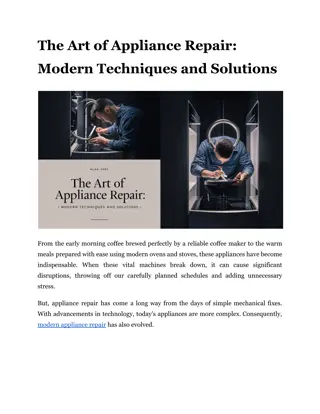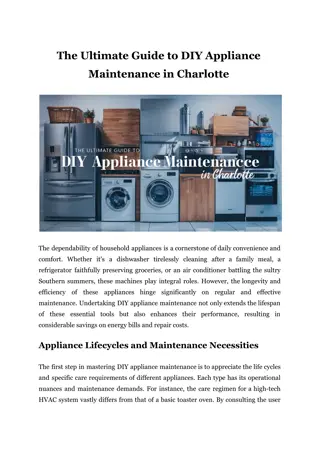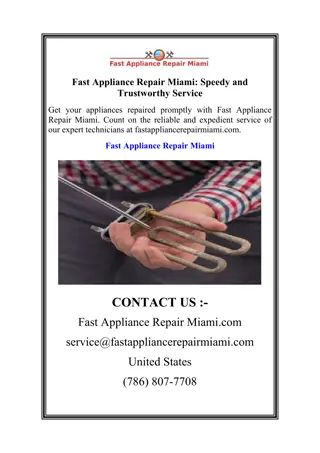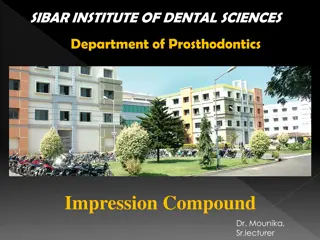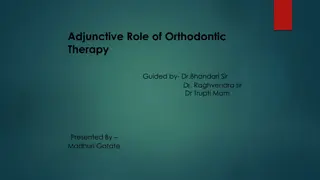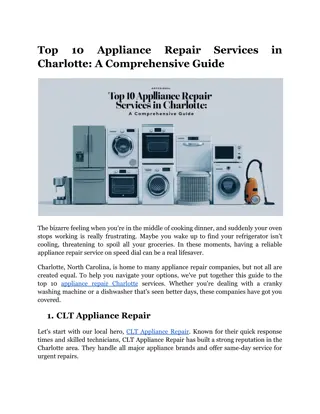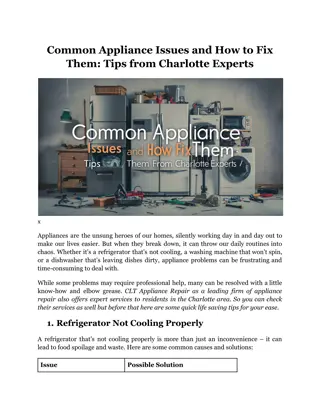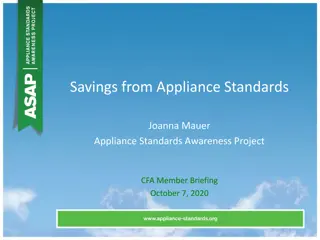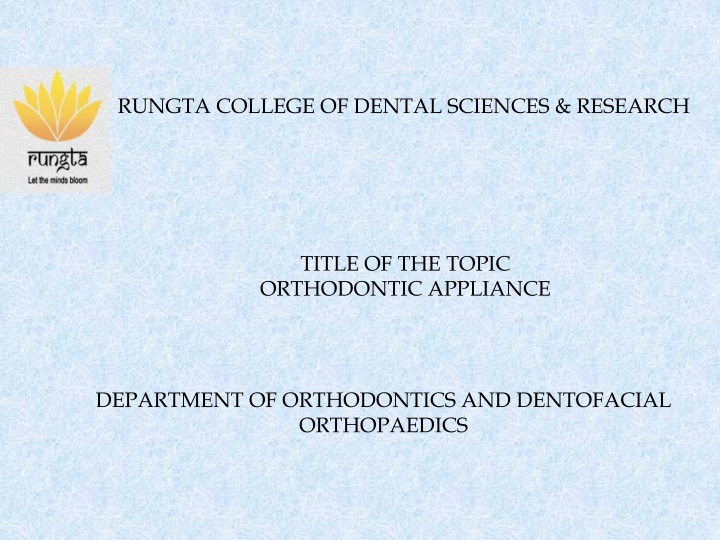
Advantages and Disadvantages of Removable Orthodontic Appliances
"Learn about the benefits and drawbacks of removable orthodontic appliances, including easier oral hygiene maintenance, cost-effectiveness, and limitations in tooth movement control. Understand how these appliances are used, their advantages such as easy fabrication, and drawbacks like restricted treatment scope."
Download Presentation

Please find below an Image/Link to download the presentation.
The content on the website is provided AS IS for your information and personal use only. It may not be sold, licensed, or shared on other websites without obtaining consent from the author. If you encounter any issues during the download, it is possible that the publisher has removed the file from their server.
You are allowed to download the files provided on this website for personal or commercial use, subject to the condition that they are used lawfully. All files are the property of their respective owners.
The content on the website is provided AS IS for your information and personal use only. It may not be sold, licensed, or shared on other websites without obtaining consent from the author.
E N D
Presentation Transcript
RUNGTA COLLEGE OF DENTAL SCIENCES & RESEARCH TITLE OF THE TOPIC ORTHODONTIC APPLIANCE DEPARTMENT OF ORTHODONTICS AND DENTOFACIAL ORTHOPAEDICS
Specific learning Objectives CORE AREAS DEFINITIONS ADVANTAGES DISADVANTAGES COMPONENTS CLASPS BOWS SPRINGS RETRACTORS SCREWS BASE PLATE DOMAIN CATEGORY NICE TO KNOW NICE TO KNOW AFFECTIVE COGNITIVE COGNITIVE PSYCHOMOTOR PSYCHOMOTOR PSYCHOMOTOR PSYCHOMOTOR PSYCHOMOTOR PSYCHOMOTOR MUST KNOW MUST KNOW NICE TO KNOW MUST KNOW NICE TO KNOW NICE TO KNOW DESIRE TO KNOW
Content Definition Advantages of removable orthodontic appliance Disadvantages Components Clasps Bows Springs Retractor Screws Base Plate Summary
Definition Removable orthodontics appliances refers to those devices that can be inserted into and removed from the oral cavity by the patient will .
Advantages of removable orthodontic appliance Removable nature of appliance make it possible for the patient to maintain good oral hygiene during treatment take less chair side time for orthodontics , as they are fabricated in laboratory Damaged appliances can be removed by patients . Apparently simple to fabricate, use and adjust. Hence require minimal chair time Less orthodontic scars compared to fixed appliances such as decalcification, caries under molar bands and white spots around bonded brackets and gingivitis.
Cost-effective Efficient to use for certain type of tooth movements Removable appliances are the appliances of choice in the first stage of the correction of a posterior crossbite They are used commonly during mixed dentition for treatment of a variety of interceptive procedures. If one considers the factors of risk and the relationship between work volume and effect, removable appliances deserve preference.
Disadvantages Not effective with uncooperative patient Only treat the minor cases of malocclusion Only capable of tipping tooth movement Limited control over tooth movement Only certain types of malocclusion can be corrected. Tooth movement in three dimensions is not possible. May hinder with speech and eating Appliances may be lost or broken Residual monomer of acrylic resin may cause allergy and/or irritation.
Components of removable appliances Retentive component Various types of clasps Active component a.Spring b.Bows c.Retractors d.Elastics Base plate
Retentive component 1. They are the component that help in keeping the appliance in place and resist displacement . 2. Adequate retention of a removable appliance is achieved by incorporating certain wire component that engage undercuts on the teeth . 3. These wire components that aid in retention of a removable appliance are called clasp . Mode of action of clasp 1.clasps act by engaging certain constricted areas of the teeth that are called undercuts. 2.When clasps are fabricated the wire is made to engage these undercuts so that there displacement is prevented .
Requirement of ideal clasp 1. It should offer adequate retention . 2. It should permit usage in both fully erupted as well as partially erupted teeth . 3. They should not themselves apply any active force that would bring about undesired tooth movement of the anchorage teeth . 4. It should be easy to fabricate . 5. It should not impinge on the soft tissues . 6. It should not interfere with normal occlusion .
Circumferential clasp It is also known as three-quarter clasp or `C clasp . They are simple clasp that are designed to engage the bucco-cervical undercut This clasp cannot be used in partially erupted teeth where the cervical undercut is not available for clasp fabrication .
Adaptation :- A wire is engaged from one proximal undercut along the cervical margin then carried over the occlusal embrasure to end as a single retentive arm on the lingual aspect that gets embedded in the acrylic base plate Advantages :- Simple design and fabrication Disadvantage :- It cannot be used in partially erupted teeth wherein cervical undercut is not avilable fo clasp fabrication
Adams clasp Adams clasp was first described by professor phillip Adams . it is also known as liverpool clasp ,universal clasp and modified arrowhead clasp . The clasp is constructed using 0.7mm hard round stainles steel wire . Adams clasp is made up of three parts (a) two arrowheads (b)bridge (c)two retentive arms Two arrow heads engage the mesial and the distal proximal undercuts . The arrow heads are connected to each other by a bridge that is at 45 degree to the long axis of the root
Advantages of adams clasp It is rigid and offers excellent retention It can be fabricated on decidious as well as permanent teeth. They can be used in partially or fully erupted teeth. It can e used on molars ,premolars and on incisors . No special instrument is needed . It is small and occupies minimum space . The clasp can be modified in a number of ways .
Active component of removable orthodontic appliances They are components of the appliances that exert forces to bring about the necessary tooth movements . The active component includes : (a) bows (b)springs (c)screws (d)elastics
Bows Bows are active components that are mostly used for incisor retraction . Types of the bows : (a) Short labial bows : They are constructed using 0.7mm hard round stainless steel wire . It consist of bow that make contact with the most prominent labial teeth and two U loops that ends as retentive arms distal to the canine . The short labial bow is activated by compressing the U loop . Indication : Minor overjet reduction and anterior space closure .
(b) Long labial bows This labial bow is similar to the short labial bow except that it extends from one first premolar to opposite first premolar . The distal arms of the U loops are adapted over the occlusal embrasure between the two premolars to get embedded in the acrylic plate . Indications : minor anterior space closure minor overjet reduction closure of space distal to canine guidance of canine during canine retraction using palatal retractor as a retaining device at the end of fixed orthodontic treatment
(c) Split labial bow This is a labial bow that is split in the middle . This result in two seprate buccal arms having a U loop each . This type of labial bow show the increase flexiblity as compared to the conventional short labial bows . This type of labial bow is used for anterior retraction . The split bow is activated by compressing the U loop 1-2mm at a time .
Springs : Springs are the active component of removable orthodontic appliance that are used to effect various tooth movements . Classification of springs (1) Based on the presence or absence of helix they can be classified as simple without helix compound with helix (2) Based on the presence of loop or helix they can be classified as helical springs have a helix looped springs have a loop (3) Based on the nature of stability of the springs they can be classified as : self supported spring - made of thicker gauge wire ,can support themselves supported springs - made of thinner gauge wire and thus lack adequate stability , springs are encased in metallic tube to give adequate support .
Ideal requisites of a spring a) the spring should be simple to fabricate . b) it should be easily adjustable . c) It should fit into the available space with out discomfort to the patient . d) It should be easy to clean . e) It should apply force of required magnitude and direction. f) It should not slip or dislodge when placed over a sloping tooth surface . g) It should be roust . h) It should remain active over a long period of time .
Factor to be considered in designing a spring a)Diameter of wire :- flexibility of the spring to a large extent depends upon diameter of wire F = D /L3 F= force applied by spring D=diameter of wire L= length of wire where b) Length of wire :- force can be decreased by increasing the length of wire. By doubling the length of wire force can be reduced by eight times . c) Patient comfort d) Direction of tooth movement
Finger spring Finger spring is also called single cantilever spring as one end is fixed in acrylic and the other end is free . It is constructed using 0.6mm wire . It consist of active arm of 12-15mm length ,a helix of 3mm internal diameter and retentive arm of 4-5 mm length . It is used for mesio distal tooth movement when teeth are located correctly in bucco lingual direction i.e. teeth should be within the line of arch it is activated by moving active arm toward the teeth intended to be moved .
Z spring The z spring is also called double cantilever spring . It is made up of 0.5mm wire . It is used for labial movement of incisor and minor rotation of incisors The spring consist of two coil of very small internal diameter . it should be placed perpendicular to palatal surface of tooth . The spring can be made for movement of single incisor or two incisor . It is activated by opening helices by about 2-3 mm at a time
Coffin spring The spring was introduced by Walter Coffin It is made of 1.2mm wire . It consist of a u or omega shaped wire placed in the midpalatal region with retentive arm incorporated in base plates . it gains retention by adams clasp in first molar and on first premolar . it is used in slow dentoalveolar arch expansion in patient with upper arch constriction or in unilateral crossbite.
Canine retractors Canine retractors are springs that are used to move canine in a distal direction . classification of canine retractors a) Based on their location 1. buccal canine retractor 2.palatal canine retractor b) Based on the presence of helix or loop 1.canine retractor with helix 2.canine retractor with loop c) Based on their mode of action- 1.push type 2.pull type
U loop canine retractor It is made up of 0.6 or 0.7 mm wire . It consist of u loop , an active arm and a retentive arm that is distal . The base of the U loop should be 2-3mm below the cervical margin The mesial arm of U loop is bent at right angles and adapted around the canine It is used when minimum retraction of 1-2mm is required . It is activated by closing loop by 1-2mm or cutting the free end of active arm by 2mm and readapting.
Helical canine retractor It is also called reverse loop canine retractor and is made of 0.6 mm wire . It consist of a coil of 3mm diameter , an active arm and a retentive arm . The mesial arm is adapted between the premolar ,the distal arm is active and it bend at the right angle to engage the canine below the height of contour, the coil is placed 3-4 mm below the gingival margin It is activated by opening helix by 1mm or by cutting 1mm of free end and readapting it around the canine .
Buccal canine retractor It is indicated in bucally placed canine and canines placed high in the vestibule . They are used to move canine in distal as well as palatal direction . It consist of a coil of 3mm diameter , an active arm and a retentive arm . Buccal canine retractor are of two types supported self supported Self supported are made of thicker gauge wire(0.7mm) so that the spring can support itself and.Supported are made of thinner gauge wire (0.5mm) thus they are more flexible and mechanically efficient Activation closing the helix 1mm at a time while supported canine retracter can be activated 2 mm at a time
Palatal canine retractor It is made up of 0.6mm wire . It consist of coil of 3mm diameter , an active arm and a guide arm . The active arm is placed mesial to canine The helix is placed along the long axis of canine It is indicated in canine that are palatally placed . Activation is done by opening the helix 2mm at a time .
Screws Screw are active component that can be incorporated in a removable appliance . Screw can be activated by the patient at regular intervals using a key . Removable appliances having a screw usually consist of split acrylic plate and adams clasps on the posterior teeth. The screw is placed connecting the split acrylic plate .
Screw can bring about three types of movement :- (a) expansion of arch . (b) movement of one or a group of teeth in a buccal or labial direction . (c) movement of one or more teeth in a distal or mesial direction
Base plate The bulk of removable appliance is made of the acrylic base plate . The prime function of the base plate is to incorporate all the components together into the single function unit .
Uses of base plates in removable appliances : (a)The base plate unites all the components of the appliance into one unit . (b) Helps in anchoring the appliance in place . (c) It provides support for the wire components . (d) Helps in distributing the forces over a larger area . (e) Bite planes can be incorporated into the plate to treat specific orthodontic problems . (f) Baseplate of 1.5 to 2mm thickness offers adequate strength.
Summary Removable appliances need a careful use and thoughtful design by the clinician with regards to anchorage and type of tooth movement required and therefore clear instructions to the laboratory technician are a must. The spring designs should be preferably drawn on the laboratory requisition form with specified size of the wire to be used for each of the components and modifications from conventional design if any desired for individual patients need. Removable appliances do have a significant role in an orthodontic armamentarium, particularly during interceptive orthodontics, in conjunction with fixed appliance therapy and during the retention phase.
REFERENCES Textbook of Orthodontics Gurkeerat Singh, Jaypee Brothers; 2nd Edition Orthodontics The Art and Science, S.I Bhalajhi, AryaMedi Publishing; 7th Edition Textbook of Orthodontics Sridhar Premkumar, Elsevier; 1st Edition Orthodontics: Diagnosis and Management of Malocclusion and Dentofacial Deformities O.P Kharbanda, Elsevier; 1st Edition




